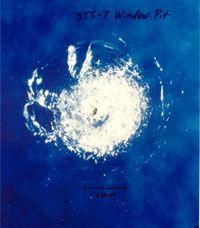In summer 2009, Jordan Olliges was a senior majoring in Aerospace Engineering at the University of Southern California. He plans to continue his education at USC with a Master’s Degree in Aerospace Design before pursuing a career in launch vehicle development.
Over the past 50 years, man’s growing presence in space has led to an increasing amount of debris orbiting Earth. With contemporary society’s heavy reliance on the technology orbiting the planet, the risk of collisions endangers the way man utilizes space. Existing concepts to remove orbital debris are not feasible and the increasing threat of fragmentation poses a substantial hazard to current and future manned and unmanned space missions. Though the United Nations has created guidelines to mitigate orbital debris generation, fragmentation events continue to occur and a stronger international focus on avoiding future satellite collisions is needed.
Introduction
In a scene predicting a grim future for our world, Disney and Pixar’s Wall-E hitches a ride on a rocket launching from the surface of the Earth. As the vehicle leaves the gravitational pull of the planet, it passes through a veritable wall of orbital debris and has to break through a mass of unused satellites and neglected spacecraft [1]. Though this particular vision is fictional, recent events within the international community have raised the level of concern that future hazards for manmade spacecraft might not be too far removed from the perils confronting Disney’s animated robot. Earth’s orbits are currently not as crowded as those in Wall-E, but the growing amount of orbiting debris does pose new problems for future satellites and manned space missions. For current Space Shuttle missions, the largest threat to the operation is no longer launch or reentry, but the dangers of orbiting trash (see Fig. 1) [2]. The hazards of orbital debris that endanger the shuttle and other satellite missions have come into the limelight as a glaring challenge to man’s continued success in space. Although the United Nations has made guidelines to curb the dangers caused by the escalating cloud of debris, the problem requires more international attention to mitigate the threat of fragmentation plaguing the planet’s orbits.
Beginning with the launch of Sputnik on October 4, 1957, man’s fascination with space has given rise to an escalating presence in Earth’s orbit [3]. From commercial communications satellites to the International Space Station [4], man-made objects populate the skies around our planet. Over the last 50 years, society has benefited from these orbital advancements and continues to become more and more reliant on the technology orbiting Earth. Contemporary culture revolves around access to internet, television, cell phones and GPS – all of which utilize satellites for data communication. With man’s ever-increasing presence in space, however, comes an ever-increasing presence of space debris. Every satellite that is launched into orbit is accompanied by a plethora of used rocket motors and spent fuel tanks. Antiquated satellites explode from residual propellant pressure or old batteries, sending fragmented pieces of garbage tumbling into the same orbital regimes employed by operational spacecraft and manned space missions. With many countries fostering new space programs and numerous nations already launching satellites, the orbital debris issue will only get worse in the coming years.
The question now becomes: who gets to make the rules? Who becomes the garbage collector and who becomes the air traffic controller? The more populated orbits become, the more dangerous they are for other satellites, and as the Chinese showed in 2007, one country’s neglect for the serenity of space can have significant impact on the rest of the world.
On January 11, 2007, the People’s Republic of China tested an anti-satellite (ASAT) weapon and destroyed its own Fengyun-1C meteorological satellite [5]. A ballistic interceptor was launched from a Chinese launch site and impacted the 960 kg satellite in orbit. The incident was the largest fragmentation event in the history of manned space operations and the debris from it accounts for more than 25% of all cataloged objects in Low Earth Orbit (LEO) [6]. Large fragmentation events have a significant impact on the total number of orbiting debris and have been on the rise for the last 50 years [7]. The Fengyun-1C fragmentation event created a dramatic increase in total orbital objects during 2007, and as of January 2009, there were 2,378 Fengyun-1C fragments larger than 5 cm being tracked by the U.S. Space Surveillance Network. The total number of fragments larger than 1 cm created by the ASAT test was estimated to be greater than 150,000 [8].
Even with China creating massive debris clouds, the U.S. Space Surveillance Network (SSN) has historically held the responsibility of tracking all objects larger than 10 cm orbiting the Earth [9]. A combination of ground-based radar and optical equipment is used to track more than 17,000 of these larger diameter particles while more focused radar systems with higher spatial resolutions can make estimates of the amount of smaller debris [10] [2]. During NASA’s Space Shuttle missions, the U.S. Space Surveillance Network studies the trajectories of the larger objects and determines if anything will endanger the astronauts. If there is greater than a 1 in 10,000 chance of collision, the shuttle will maneuver away from the incoming object [9]. Similarly to NASA, mission planners for the International Space Station (ISS) rely heavily on the Space Surveillance Network to continually monitor orbital debris and determine if there is a threat to the human inhabitants on board. Like the Shuttle, the ISS can maneuver away from objects larger than 10 cm. To protect the astronauts from smaller debris, the station is the heaviest shielded vehicle ever launched into orbit and can withstand particle impacts of up to 1 cm in diameter [11]. However, the gap between survivable 1 cm objects and tracked 10 cm objects is of big concern to manned missions. With an average relative velocity of 10 km/s between two objects in LEO, an impact with anything larger than 1 cm would be catastrophic to a manned space mission [9]. With no way to avoid these intermediate-sized objects, an international focus on debris mitigation is vital to keeping space safe for future manned missions.
Orbital Elements and the Dangers of Space Debris
Satellites revolving around the Earth travel in either a circular or elliptical orbit. These orbits range in altitudes from 200- 2000 km for LEO, all the way up to 35,786 km for geostationary orbits (GEO) [12]. The velocities of the satellites throughout their orbits are proportional to the altitudes. For example, the ISS is in a circular orbit at an altitude of roughly 350 km. This corresponds to an orbital velocity of 7.7 km/s (17,200 mph) and the station completes a full orbit of the earth in just over 90 minutes [4]. On the other hand, a spacecraft designed to transmit a satellite TV broadcast would be designed to reside in GEO, travel at 3.3 km/s (7,400 mph) and have a period of 24 hours.
The angle between the orbital plane of the satellite and the equatorial plane of the Earth may also vary. The angle between the two planes is called the inclination angle of the orbit. To visualize the inclination angle, imagine you are standing up straight, your waist is Earth’s equator, and you are holding a hula hoop to symbolize the orbit of a satellite. If you place your hands on the sides of the hula hoop, level with your waist, and hold it parallel to the ground, the orbit has zero inclination. If you keep your hands level with your waist but start to twist the hula hoop up, pivoting it about a line drawn from one hand, through your waist, to the other hand, you are changing the inclination of the orbit. If you now rotate your shoulders so instead of being at your sides, your right hand is slightly in front of you and your left is slightly behind, you have changed the right ascension of ascending node (RAAN) of the orbit. The orbital inclination and right ascension of ascending node are important parameters for understanding how space debris can affect other spacecraft.
When a piece of debris impacts a satellite (or another piece of space junk), an enormous amount of energy is released due to the high velocities of the objects. For example, a 100 g piece of debris (usually 6-10 cm) hitting a satellite with a relative velocity of 10 km/s has the same kinetic energy as 1 kg of TNT [13]. This can blow the satellite into thousands of fragments with each piece projected away from the crash with varying velocity and direction. Because the velocities of the pieces are no longer the same as the original spacecraft, they all have their own orbits and thus different periods and altitudes than the original spacecraft (see Fig. 2).
Even though they have new orbits, the majority of the fragments are still clustered relatively close together immediately after impact and follow the same general orbital trajectory of the original satellite. Over time, however, these orbits begin to disperse due to what is called the regression of nodes [11]. If the Earth were a perfect sphere with evenly distributed mass, the gravitational pull would always be directly towards the center of the planet and in the plane of the orbit. Earth actually has slight bulge around the equator, causing part of the gravitational force vector to be out of the orbit plane, which in turn causes the right ascension of the ascending node, or RAAN. The gravitational force of the Sun and the Moon also contribute to the regression of nodes, but Earth’s oblateness is the dominating factor [11]. The rate at which the node regresses is a function of the inclination and period of the orbit. After a fragmentation event, the debris is cast into orbits with different periods and inclination angles, and each orbit changes orientation at a different rate. Over time the orbits begin to spread out because of the variance in nodal regression rate. In the case of the Fengyun 1-C anti-satellite weapons test, since the debris was distributed across such a wide range of altitudes and orbital periods, the precession rates caused the fragments to envelope the globe and create a shell of orbiting debris in a short period of time, roughly 12 months [14]. Within one year, the orbital debris had almost completely encircled the Earth, clearly indicating the worldwide risk posed by fragmentation events.
International Mitigation Efforts
Even though orbital vehicles are becoming an essential part of many countries’ national infrastructure, the majority of the hazardous debris in orbit is created by a select few. As of January 1, 2008, the three leading offenders were China, the United States, and Russia. The People’s Republic of China accounts for nearly half of all debris orbiting the Earth, largely in part to the Fengyun-1C’s intentional destruction. However, a large issue with orbital debris is how its impact extends beyond the country of origin and affects the entire world.
Due to the nature of objects in Low Earth Orbit, one country’s orbital pollution contaminates space for the entire international community. Unlike geostationary orbit, where a satellite stays positioned directly above a single point on the Earth’s surface, the shorter periods of satellites in LEO result in them outpacing the Earth’s rotation. With all low orbiting objects encircling the entire globe, there is no way to only clear up the sky above a certain country.
To address the growing orbital debris hazards to every countries’ satellites, the international space community brought a renewed fervor for mitigating space debris generation after the Fengyun-1C ASAT test. There has been extensive thought supplied by the world’s space programs towards finding a way to remove trash from orbit, but as the Chief Scientist for NASA’s Orbital Debris Program Office, Nicholas Johnson, said, the space community hasn’t “found a single concept which is both technically feasible and economically viable” [15]. Some of the more exotic ideas that have surfaced include using ground or space-based lasers to push the orbiting trash into lower orbits or even launching a mile-wide NERF ball in the hopes that debris impacting it would slow down enough to drop altitude and disintegrate in the atmosphere. Because these concepts have not proved practical, the mitigation effort has focused less on cleaning up what is already in orbit and more on preventing the production of future space debris. Even though this is a limited approach to debris mitigation, it is a step in the right direction by the space community.
In February 2007, the United Nation’s Scientific and Technical Subcommittee of the Committee on the Peaceful Uses of Outer Space developed a set of guidelines to be followed by “member states and international organizations” to help tackle current and future issues with debris generation [16]. The committee found that space debris mitigation could be separated into two general categories: first, restricting new debris production by curtailing the waste coming off of current missions to prevent future fragmentation events, and second, creating end-of-life procedures for removing spacecraft and launch vehicle stages from populated orbital regimes. The issued guidelines focused not only on minimizing the potential for satellite breakups and debris released during normal operations, but called for a stop to intentional satellite destruction and for countries to moderate the lifetime of decommissioned satellites in populated orbital regions [16]. The guidelines require that a satellite include excess propellant on board to send the spacecraft into a less populated orbit at the end of its mission, thus diminishing its chances for a collision.
Even with a global commitment to debris mitigation efforts, the hazards of orbital fragments have not been mollified. On February 11, 2009, an American-made commercial satellite crashed into a Russian satellite in the first ever large inter-satellite collision [2]. A 560 kg Iridium satellite used for global satellite voice and data communications was impacted by a 900 kg non-operational Russian satellite 790 km over Siberia [17] [18]. The high energy impact sent debris in orbits ranging from 480 km to 1300 km above the Earth [19]. This increase in the total number of orbital objects yields higher probability of future fragmentation events and dramatically increases the danger to satellites with similar orbital altitudes.
The UN mitigation guidelines are a positive step towards safer orbital regimes, but to ensure that man’s presence in space can continue, more priority has to be placed on protecting Earth’s satellites. As the recent satellite collision shows, the hazards of orbital debris may require a stronger technological footing to ensure the safety of future satellites and manned space missions. Space missions may need a heavier emphasis on debris tracking and fragment simulation so operational vehicles can avoid the fragments already in orbit. Higher quality radar that can track smaller objects may be required to minimize the discrepancy between debris that can be avoided (10 cm) and debris that can be shielded (1 cm). Similarly, more computing power may be needed to monitor the debris trajectories and warn satellites to maneuver away from possible collisions. More international focus needs to be placed on preventing future fragmentation events to avoid polluting Earths populated orbital regimes. The orbital dystopia predicted by Wall-E should be kept a fictional fate envisioned by Pixar animators, not a circumstantial rendering of the future for man’s presence in space.
References
-
- [1] Wall-E. Dir. Andrew Stanton. Disney/Pixar, 2008. DVD.
- [2] (2009, Feb.). “Two Big Satellites Collide Over Siberia.” Discovery Channel News. Available: http://dsc.discovery.com/news/2009/02/11/satellite-collision.html [Mar. 2, 2009].
- [3] R. D. Launius et al. Reconsidering Sputnik. London: Routledge, 2000.
- [4] Heavens Above. “ISS – Orbit Data.” Internet: http://www.heavens-above.com/orbit.aspx?satid=25544, Mar. 9, 2009 [Mar. 9, 2009].
- [5] “Chinese Anti-satellite Test Creates Most Severe Orbital Debris Cloud in History.” NASA Orbital Debris Quarterly News, vol. 11.2, Apr. 2007.
- [6] L. David. (2007, Feb.). “China’s Anti-Satellite Test: Worrisome Debris Cloud Circles Earth.” SPACE.com. [On-line]. Internet: http://www.space.com/news/070202_china_spacedebris.html [Mar. 2, 2009].
- [7] (2008, Jan.). “Fengyun – 1C Debris: One Year Later.” NASA Orbital Debris Quarterly News. 12.1.
- [8] (2009, Jan.). “Fengyun – 1C Debris: Two Years Later.” NASA Orbital Debris Quarterly News. 13.1.
- [9] NASA Orbital Debris Program Office. “Orbital Debris Frequently Asked Questions.” Internet: http://orbitaldebris.jsc.nasa.gov/faqs.html#3, Mar. 18, 2008 [Mar. 9, 2009].
- [10] Scientific and Technical Subcommittee of the United Nations Committee on the Peaceful uses of Outer Space. “Technical Report on Space Debris.” (1999). United Nations Publication. [On-line]. Available: http://www.unoosa.org/pdf/reports/ac105/AC105_720E.pdf [Mar. 2, 2009].
- [11] M. Gruntman. “Orbital Mechanics.” Space Craft Design Section 4. University of Southern California, ASTE-520. Spring 2009.
- [12] “IADC Space Debris Mitigation Guidelines.” Inter-Agency Space Debris Coordination Committee. [Oct. 15, 2002].
- [13] R. A. Madler and D. S. McKnight. Space Mission Analysis and Design. Springer, 2007, pp. 840-852.
- [14] N. L. Johnson et al. (2008). “The Characteristics and Consequences of the Break-up of the Fungyun-1C Spacecraft. Acta Astronautica, vol. 63, pp. 128-135.
- [15] J. Bryner. (2008, Mar.). “Cosmic Clean-Up: Wild Ideas to Sweep Space.” SPACE.com. [On-line]. Available: http://www.space.com/businesstechnology/080319-tw-space-debris.html [Apr. 4, 2009].
- [16] “Report of the Scientific and Technical Subcommittee on Its Forty-fourth Session,” presented at the Committee on the Peaceful Uses of Outer Space, 2007.
- [17] Iridium Satellite LLC. “Company Profile.” Internet: http://www.iridium.com/ about/about.php, 2007 [Mar. 8, 2009].
- [18] B. Harwood. (2009, Feb.). “U.S. and Russian satellites collide.” Cnet News. [On-line]. Available: http://news.cnet.com/us-and-russian-satellites-collide [Mar. 2, 2009].
- [19] (2009, Feb.). “Debris from Satellite Collision Worries Scientists.” NPR.org. [On-line]. Available: http://www.npr.org/templates/story/story.php?storyId=100632493 [Mar. 8, 2009].
- [20] R. Courtland. (2008, Jun.). “Weak solar cycle may keep more space junk in orbit.” New Scientist. [On-line]. Available: http://www.newscientist.com/article/dn14207-weak-solar-cycle-may-keep-more-space-junk-in-orbit.html [Mar. 2, 2009].
- [21] J. Pappalardo. (2008, Feb.). “New Tech to Protect Spacecraft from Space Junk.” Popular Mechanics. [On-line]. Available: http://www.popularmechanics.com/science/air_space/4243876.html [Mar. 2, 2009].
- [22] C. Pardini and L. Anselmo. “Evolution of the Debris Cloud Generated by the Fengyun-1C Fragmentation Event,” presented at the 20th International Symposium on Space Flight Dynamics, Annapolis, Maryland USA, 2007.





